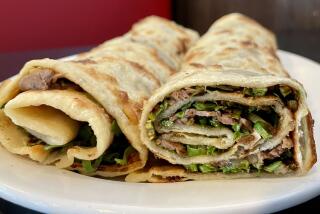Bringing Home the Artisan Bacon
- Share via
“I wonder what the prospector and the hardy pioneer would think,” James Beard wrote in 1972, “of the average water-soaked, artificially flavored, indescribable substance called bacon today. It shrinks to nothing in the pan, tastes sweet, and reeks of artificial smoke. The one thing you can say for it is that it looks pretty in the package. Some good bacon is, however, still available.”
I found some of that good bacon. My cousin David sent it to me.
Once a sous-chef at Engine Co. No. 28 and chef at the defunct Red Car Grill in Los Angeles, David now is at Three Square Grill, a small but admired restaurant he runs with his wife, Barb, in the Hillsdale neighborhood of Portland, Ore.
It’s hard to raise pigs in metropolitan Portland--they tend to burrow under fences--but David does the next best thing. He buys young red Durocs (raised on goat whey, with no antibiotics) at Juniper Grove Farm in Redmond, Ore., periodically checks on their growth, and when they’re about 6 months old hauls them to a processing plant. He brings home about 200 pounds per pig, in the form of pork loin chops, ham hocks, pork ribs, feet (for stock), offal, meat from the jowls (which, when dried, cured and seasoned, is known in Italy as guanciale) and belly that will become bacon.
At the restaurant, he packs the slab bacon in salt, honey, black pepper and a small amount of nitrate, and refrigerates it for at least 21 days, draining and changing the cure and rotating the bellies once a week. When the fat becomes translucent and hard, David soaks and rinses the meat, and then smokes it with hickory for two or three hours. The result is perfection.
“The stuff is like candy,” he says. “There’s so much meat, and so much fat, in nice alternating layers.”
The first time David made bacon, he used it generously at the restaurant--in BLTs, with breakfast and in tarts (see recipe). It proved too popular and was gone within days. Now he reserves the special meat for mixed-grill dinners, and his customers howl for it like coyotes.
Not everyone has the expertise or drive to oversee the raising, butchering and curing of his own meats. But superior bacon is available if you’re willing to pay a little more or look a little harder. Niman Ranch sells pretty good bacon, and your butcher probably has thick slices of something decent. Or you can join the Grateful Palate’s Bacon of the Month Club and get 12 varieties of artisan pig meat (not to mention a little toy pig and other frills).
True, the market remains dominated by over-chemicaled, water-saturated bacon. But with more and more dedicated small-batch producers, pork belly futures are definitely looking up.
*
Savory Bacon Tart
Serves 8 to 10
1 3/4 cups heavy whipping cream
3 large eggs, whisked to combine them
1 cup aged firm goat cheese, grated
Pinch of nutmeg
Freshly ground pepper to taste
1/2 pound good-quality bacon, julienned, cooked but not crisp (reserve fat)
1 cup sliced sweet onion, sauteed in bacon fat until soft
1/2 cup chopped cooked spinach (6 ounces uncooked)
1 partially baked 10-inch tart shell, homemade or purchased
Heat oven to 350 degrees. In a heavy saucepan, heat cream until barely simmering. Remove from heat and slowly whisk in eggs a little at a time. Stir in cheese, nutmeg and pepper. Place the bacon, onion and cooked spinach in the tart shell and pour the egg mixture over them. Bake until a knife inserted in the center comes out clean, about 35 minutes. Cool at least 15 minutes before serving. Serve warm.
*
Resource Guide
Niman Ranch, www.nimanranch.com; The Grateful Palate’s Bacon of the Month Club, www.gratefulpalate.com
*
Phil Barber last wrote for the magazine about corn fritters.
More to Read
Eat your way across L.A.
Get our weekly Tasting Notes newsletter for reviews, news and more.
You may occasionally receive promotional content from the Los Angeles Times.









